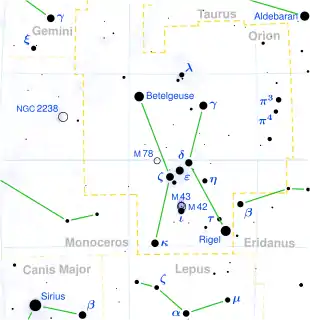22 Orionis
22 Orionis is a binary star[12] in the equatorial constellation of Orion. It has the Bayer designation o Orionis, while 22 Orionis is the Flamsteed designation. This system is visible to the naked eye as a faint, blue-white hued star with an apparent visual magnitude of 4.74.[2] It is located approximately 1,100 light years away from the Sun based on parallax.[1] The system is moving further from the Earth with a heliocentric radial velocity of +28.80[5]
| Observation data Epoch J2000 Equinox J2000 | |
|---|---|
| Constellation | Orion |
| Right ascension | 05h 21m 45.74861s[1] |
| Declination | 0° 22′ 56.9105″[1] |
| Apparent magnitude (V) | 4.74[2] |
| Characteristics | |
| Spectral type | B2 IV-V[3][4] |
| U−B color index | -0.79[2] |
| B−V color index | -0.16[2] |
| Astrometry | |
| Radial velocity (Rv) | +28.80[5] km/s |
| Proper motion (μ) | RA: −1.320[1] mas/yr Dec.: +3.457[1] mas/yr |
| Parallax (π) | 2.8672 ± 0.3512[1] mas |
| Distance | approx. 1,100 ly (approx. 350 pc) |
| Absolute magnitude (MV) | −2.98[6] |
| Orbit[7] | |
| Period (P) | 293 days |
| Eccentricity (e) | 0.15 |
| Periastron epoch (T) | 2,442,175 JD |
| Argument of periastron (ω) (secondary) | 234° |
| Semi-amplitude (K1) (primary) | 4.1 km/s |
| Details | |
| 22 Ori A | |
| Mass | 9.0[8] M☉ |
| Luminosity | 741[9] L☉ |
| Surface gravity (log g) | 3.56[10] cgs |
| Temperature | 19,953[9] K |
| Metallicity [Fe/H] | −0.06[10] dex |
| Rotational velocity (v sin i) | 9[9] km/s |
| Age | 18.5[8] Myr |
| Other designations | |
| Database references | |
| SIMBAD | data |
This is a single-lined spectroscopic binary with an orbital period of 293 days and an eccentricity of 0.15.[7] The visible member, component A, has a stellar classification of B2 IV-V,[3][4] matching a B-type star with a luminosity class that displays mixed traits of a main sequence star and a subgiant. It is a suspected Beta Cephei variable[13] or a slowly pulsating B star.[14] The star has nine[8] times the mass of the Sun and is radiating 741 times the Sun's luminosity[9] from its photosphere at an effective temperature of 19,953 K.[9]
References
- Brown, A. G. A.; et al. (Gaia collaboration) (August 2018). "Gaia Data Release 2: Summary of the contents and survey properties". Astronomy & Astrophysics. 616. A1. arXiv:1804.09365. Bibcode:2018A&A...616A...1G. doi:10.1051/0004-6361/201833051. Gaia DR2 record for this source at VizieR.
- Ducati, J. R. (2002). "VizieR Online Data Catalog: Catalogue of Stellar Photometry in Johnson's 11-color system". CDS/ADC Collection of Electronic Catalogues. 2237. Bibcode:2002yCat.2237....0D.
- van Belle, Gerard T.; von Braun, Kaspar (2009). "Directly Determined Linear Radii and Effective Temperatures of Exoplanet Host Stars". The Astrophysical Journal (abstract). 694 (2): 1085–1098. arXiv:0901.1206. Bibcode:2009ApJ...694.1085V. doi:10.1088/0004-637X/694/2/1085.
- Hoffleit, D.; Warren, W. H. (1995). "VizieR Online Data Catalog: Bright Star Catalogue, 5th Revised Ed. (Hoffleit+, 1991)". VizieR On-line Data Catalog: V/50. Originally Published in: 1964BS....C......0H. 5050. Bibcode:1995yCat.5050....0H.
- Wilson, R. E. (1953). General Catalogue of Stellar Radial Velocities. Carnegie Institution for Science. Bibcode:1953GCRV..C......0W. LCCN 54001336.
- Anderson, E.; Francis, Ch. (2012). "XHIP: An extended hipparcos compilation". Astronomy Letters. 38 (5): 331. arXiv:1108.4971. Bibcode:2012AstL...38..331A. doi:10.1134/S1063773712050015. Vizier catalog entry
- Abt, H. A.; Levy, S. G. (1978). "Binaries among B2-B5 IV, V absorption and emission stars". The Astrophysical Journal Supplement Series. 36: 241–258. Bibcode:1978ApJS...36..241A. doi:10.1086/190498.
- Tetzlaff, N.; Neuhäuser, R.; Hohle, M. M. (2011). "A catalogue of young runaway Hipparcos stars within 3 kpc from the Sun". Monthly Notices of the Royal Astronomical Society. 410: 190. arXiv:1007.4883. Bibcode:2011MNRAS.410..190T. doi:10.1111/j.1365-2966.2010.17434.x. Vizier catalog entry
- Simón-Díaz, S.; Godart, M.; Castro, N.; Herrero, A.; Aerts, C.; Puls, J.; Telting, J.; Grassitelli, L. (2017). "The IACOB project . III. New observational clues to understand macroturbulent broadening in massive O- and B-type stars". Astronomy and Astrophysics. 597: A22. arXiv:1608.05508. Bibcode:2017A&A...597A..22S. doi:10.1051/0004-6361/201628541. Vizier catalog entry
- Soubiran, Caroline; Le Campion, Jean-François; Brouillet, Nathalie; Chemin, Laurent (2016). "The PASTEL catalogue: 2016 version". Astronomy & Astrophysics. 591: A118. arXiv:1605.07384. Bibcode:2016A&A...591A.118S. doi:10.1051/0004-6361/201628497.
- "22 Ori". SIMBAD. Centre de données astronomiques de Strasbourg. Retrieved 2019-06-09.
- Eggleton, P. P.; Tokovinin, A. A. (2008). "A catalogue of multiplicity among bright stellar systems". Monthly Notices of the Royal Astronomical Society. 389 (2): 869. arXiv:0806.2878. Bibcode:2008MNRAS.389..869E. doi:10.1111/j.1365-2966.2008.13596.x.
- Samus, N. N.; Durlevich, O. V.; et al. (2009). "VizieR Online Data Catalog: General Catalogue of Variable Stars (Samus+ 2007-2013)". VizieR On-line Data Catalog: B/gcvs. Originally Published in: 2009yCat....102025S. 1. Bibcode:2009yCat....1.2025S.
- Smith, M. A. (February 1980), "Nonradial m-mode changes in the 53 Persei variable 22 Orionis", Astrophysical Journal Supplement Series, 42: 261–281, Bibcode:1980ApJS...42..261S, doi:10.1086/190651
